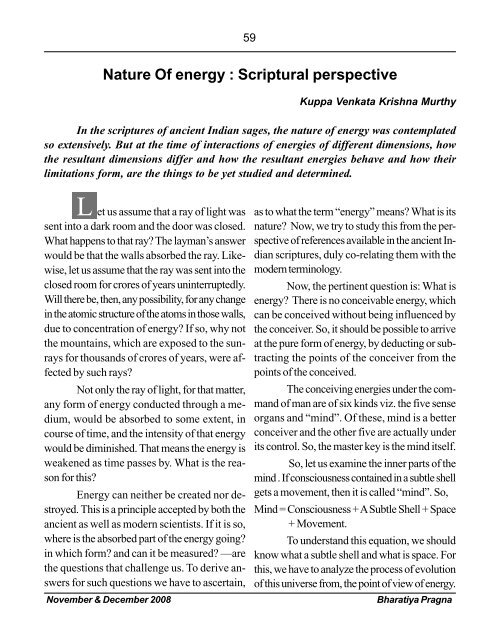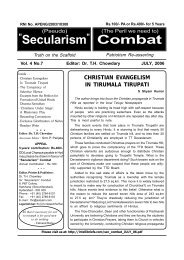Bharatiya Pragna - Dr. Th Chowdary
Bharatiya Pragna - Dr. Th Chowdary
Bharatiya Pragna - Dr. Th Chowdary
You also want an ePaper? Increase the reach of your titles
YUMPU automatically turns print PDFs into web optimized ePapers that Google loves.
L et us assume that a ray of light was<br />
sent into a dark room and the door was closed.<br />
What happens to that ray? <strong>Th</strong>e layman’s answer<br />
would be that the walls absorbed the ray. Likewise,<br />
let us assume that the ray was sent into the<br />
closed room for crores of years uninterruptedly.<br />
Will there be, then, any possibility, for any change<br />
in the atomic structure of the atoms in those walls,<br />
due to concentration of energy? If so, why not<br />
the mountains, which are exposed to the sunrays<br />
for thousands of crores of years, were affected<br />
by such rays?<br />
Not only the ray of light, for that matter,<br />
any form of energy conducted through a medium,<br />
would be absorbed to some extent, in<br />
course of time, and the intensity of that energy<br />
would be diminished. <strong>Th</strong>at means the energy is<br />
weakened as time passes by. What is the reason<br />
for this?<br />
Energy can neither be created nor destroyed.<br />
<strong>Th</strong>is is a principle accepted by both the<br />
ancient as well as modern scientists. If it is so,<br />
where is the absorbed part of the energy going?<br />
in which form? and can it be measured? —are<br />
the questions that challenge us. To derive answers<br />
for such questions we have to ascertain,<br />
59<br />
Nature Of energy : Scriptural perspective<br />
Kuppa Venkata Krishna Murthy<br />
In the scriptures of ancient Indian sages, the nature of energy was contemplated<br />
so extensively. But at the time of interactions of energies of different dimensions, how<br />
the resultant dimensions differ and how the resultant energies behave and how their<br />
limitations form, are the things to be yet studied and determined.<br />
as to what the term “energy” means? What is its<br />
nature? Now, we try to study this from the perspective<br />
of references available in the ancient Indian<br />
scriptures, duly co-relating them with the<br />
modern terminology.<br />
Now, the pertinent question is: What is<br />
energy? <strong>Th</strong>ere is no conceivable energy, which<br />
can be conceived without being influenced by<br />
the conceiver. So, it should be possible to arrive<br />
at the pure form of energy, by deducting or subtracting<br />
the points of the conceiver from the<br />
points of the conceived.<br />
<strong>Th</strong>e conceiving energies under the command<br />
of man are of six kinds viz. the five sense<br />
organs and “mind”. Of these, mind is a better<br />
conceiver and the other five are actually under<br />
its control. So, the master key is the mind itself.<br />
So, let us examine the inner parts of the<br />
mind . If consciousness contained in a subtle shell<br />
gets a movement, then it is called “mind”. So,<br />
Mind = Consciousness + A Subtle Shell + Space<br />
+ Movement.<br />
To understand this equation, we should<br />
know what a subtle shell and what is space. For<br />
this, we have to analyze the process of evolution<br />
of this universe from, the point of view of energy.<br />
November & December 2008 <strong>Bharatiya</strong> <strong>Pragna</strong>



